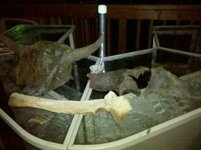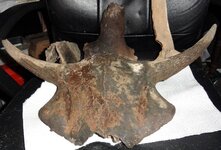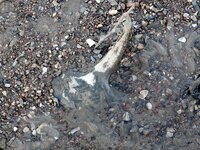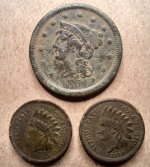DemonCatSpaceStar
Sr. Member
Bison bones & preserving bone?
Now this may be in the wrong place but I was hunting for Arrowheads when I found them so I figured what the hay!
I found the piece of horn & skull (my first buffalo horn!) 1st & it took me a few seconds to figure out what I had then I was like OMG! @ first I thought it was a piece of tree. Then I found the vertebrae about 30 - 40 yards away.
Funny story I had a guy come down & so I showed him the horn I found he said he's found full skulls there before, so he starts looking (in an area I hadn't gotten to yet & it's funny that people who come down & hunt when someone else is hunting always justify stepping on someones toes by saying "no one can find them all" ?
& it's funny that people who come down & hunt when someone else is hunting always justify stepping on someones toes by saying "no one can find them all" ?  like he said) So I start just looking around a tree thinking about giving up & leaving I took a step & there sticking out of the ground was the horn, it's not full but I'm really happy that both horns are on it!
like he said) So I start just looking around a tree thinking about giving up & leaving I took a step & there sticking out of the ground was the horn, it's not full but I'm really happy that both horns are on it! 
This is a quick pic that I took with my phone I'll get more better ones up later.
Does anyone have any advice on how to preserve bone? Now I know about the 50/50 elmers glue & water but I'm looking for a quick way to seal it with an over the counter product with no mixing involved? Like maybe in gallon containers? Has anyone tried Modpodge puzzle sealer?
Thanks for looking,
Phil 8)
Now this may be in the wrong place but I was hunting for Arrowheads when I found them so I figured what the hay!

I found the piece of horn & skull (my first buffalo horn!) 1st & it took me a few seconds to figure out what I had then I was like OMG! @ first I thought it was a piece of tree. Then I found the vertebrae about 30 - 40 yards away.
Funny story I had a guy come down & so I showed him the horn I found he said he's found full skulls there before, so he starts looking (in an area I hadn't gotten to yet
 & it's funny that people who come down & hunt when someone else is hunting always justify stepping on someones toes by saying "no one can find them all" ?
& it's funny that people who come down & hunt when someone else is hunting always justify stepping on someones toes by saying "no one can find them all" ? 
This is a quick pic that I took with my phone I'll get more better ones up later.
Does anyone have any advice on how to preserve bone? Now I know about the 50/50 elmers glue & water but I'm looking for a quick way to seal it with an over the counter product with no mixing involved? Like maybe in gallon containers? Has anyone tried Modpodge puzzle sealer?
Thanks for looking,
Phil 8)
Attachments
Upvote
0











